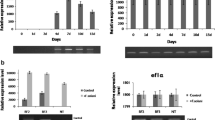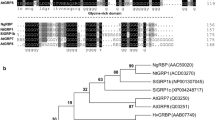Abstract
During efforts for cloning disease resistance-responsive genes, a cDNA encoding a putative Nicotiana glutinosa glycine-rich RNA binding protein (ngRBP) was isolated from TMV induced cDNA library. Northern blot hybridization revealed that ngRBP gene is negatively regulated during early hours of TMV induced acute hypersensitive response (HR). Under greenhouse conditions induced expression of ngRBP gene was observed after 24 h following TMV infection. Salicylic acid and copper also induced ngRBP mRNA expression. Our findings are suggestive of some possible role for ngRBP in plant-pathogen interaction.
Similar content being viewed by others
References
Alba MM, Culianez-Macia FA, Goday A, Freire MA, Nadal B, Pages M: The maize RNAbinding protein, MA 16, is a nucleolar protein located in the dense fibrillar component. Plant J 6: 825–834 (1994).
Bourbon H, Lapeyre B, Amalric F: Structure of mouse nucleolin gene. The complete sequence reveals that RNA binding domain is encoded by two independent exons. J Mol Biol 200: 627–638 (1988).
Carpenter CD, Kreps JA, Simon AE: Genes encoding glycinerich Arabidopsis thaliana proteins with RNAbinding motifs are influenced by cold treatment and an endogenous circadian rhythm. Plant Physiol 104: 1015–1025 (1994).
Choi D, Kim HM, Yun HK, Park JA, Kim WT, Bok SH: Molecular cloning ofmetallothioneinlike gene fromNicotiana glutinosa L. and its induction bywounding and tobacco mosaic virus infection. Plant Physiol 112: 353–359 (1996).
Cobianchi F, Karpel RL, Williams KR, Notario V, Wilson SH: Mammalian heterogeneous ribonucleoprotein complex protein A1. J Biol Chem 263: 1063–1071 (1988).
Dinesh-Kumar SP, Whitham S, Choi D, Hehl R, Corr C and Baker B: Transposon tagging of tobacco mosaic virus resistance gene N: Its possible role in the TMV-N-mediated signal transduction pathway. Proc Natl Acad Sci USA 92: 4175–4180 (1995).
Didierjean L, Frendo P, Burkard G: Stress responses in maize: sequence analysis of cDNAs encoding glycinerich proteins. Plant Mol Biol 18: 847–849 (1992).
Dreyfuss D, Matunis MJ, Pinol-Roma S, Burd CG: hnRNP proteins and the biogenesis of mRNA. Annu Rev Biochem 62: 289–321 (1993).
Dunn MA, Brown K, Lightowlers R, Hughes MA: A lowtemperatureresponsive gene from barley encodes a protein with singlestranded nucleic acidbinding activity which is phosphorylated in vitro. Plant Mol Biol 30: 947–959 (1996).
Freire MA, Pages M: Functional characteristics of the maize RNAbinding protein MA 16. Plant Mol Biol 29: 797–807 (1995).
Gomez J, Sanchez-Martinez D, Stiefel V, Rigau J, Puigdomenech P, Pages M: Agene induced by the plant hormone abscisic acid in response to water stress encodes a glycinerich protein. Nature 334: 262–264 (1988).
Hammond-Kosack KE, Jones JDG: Resistance genedependent plant defense responses. Plant Cell 8: 1773–1791 (1996).
Heintzen C, Melzer S, Fischer R, Kappeler S, Apel K, Staiger D: A light and temperatureentrained circadian clock controls expression of transcripts encoding nuclear proteins with homology to RNAbinding proteins in meristematic tissue. Plant J 5(6): 799–813 (1994).
Hirose T, Sugita M, Sugiura M: cDNA structure, expression and nucleic acidbinding properties of three RNAbinding proteins in tobacco: occurrence of tissuespecific alternative splicing. Nucl Acids Res 21: 3981–3987 (1993).
Malamy J, Hennig J, Klessig DF: Temperaturedependent induction of salicylic acid and its conjugates during the resistance to tobacco mosaic virus. Plant Cell 4: 359–366 (1992).
Nishiyama H, Itoh K, Kaneko Y, Kishishita M, Yoshida O, and Fujita J: A glycine-rich RNA-binding protein mediating coldinducible suppression of mammalian cell growth. J Cell Biol 137: 899–908 (1997).
Parish JH, Kirby KS: Reagents which reduce interactions between ribosomal RNA and rapidly labeled RNA from rat liver. Biochim Biophys Acta 129: 554–562 (1966).
Query CC, Bentley RC, Keene JD: A common RNA recognition motif identified within a defined U1 RNA binding domain of the 70K U1 snRNp protein. Cell 57: 89–101 (1989).
Ryals J, Uknes S, Ward E: Systemic acquired resistance. Plant Physiol 104: 1109–1112 (1994).
Sambrook J, Fritsch EF, Maniatis T: Molecular Cloning. Cold Spring Harbor Laboratory Press, Cold Spring Harbor, NY (1989).
Sturm A: Awoundinducible glycinerich protein from Daucus carota with homology to singlestranded nucleic aidbinding proteins. Plant Physiol 99: 1689–1692 (1992).
van Nocker S, Vierstra RD: Two cDNAs from Arabidopsis thaliana encode putative RNA binding proteins containing glycinerich domains. Plant Mol Biol 21: 695–699 (1993).
Yalpani N, León J, Lawton MA, Raskin I: Pathway of salicylic acid biosynthesis in healthy and virusinoculated tobacco. Plant Physiol 103: 315–321 (1993).
Ye L, Li Y, Fukami-Kobayashi K, Go M, Konishi T, Watanabe A, Sugiura M: Diversity of ribonucleoprotein family in tobacco chloroplast: two new ribonucleoproteins and a phylogenetic tree of ten chloroplast RNA-binding domains. Nucl Acids Res 19: 6485–6490 (1991).
Yun HK, Yi SY, Yu SH, Bok SH, Choi D: Cloning of a PR1 Gene from Nicotiana glutinosa and its Salicylic AcidIndependent Induction by Copper and βAminobutyric acid. Submitted to J Plant Physiol (1997).
Wolfe KH, Gouy M, Yang YW, Sharp PM, Li WH: Date of monocotdicot divergence estimated from chloroplast DNA sequence data. Proc Natl Acad Sci USA 86: 6201–6205 (1989).
Author information
Authors and Affiliations
Rights and permissions
About this article
Cite this article
Saqlan Naqvi, S.M., Park, KS., Yi, SY. et al. A glycine-rich RNA-binding protein gene is differentially expressed during acute hypersensitive response following Tobacco Mosaic Virus infection in tobacco. Plant Mol Biol 37, 571–576 (1998). https://doi.org/10.1023/A:1006031316476
Issue Date:
DOI: https://doi.org/10.1023/A:1006031316476




